Climate Education Resources
The University of Maine’s Climate Change Institute (CCI) is a global leader in climate research, and one of the oldest such research units in the United States. CCI scientists collaborate across disciplines and travel to many corners of the world to learn about our past and present climate and to predict what the future holds. We seek to understand how human activities can mitigate and adapt to changes that lie ahead, and are already underway.
Maine’s four-year Climate Action Plan calls for increasing public education about climate change, and enhancing educational opportunities for climate science and clean energy careers. In response, we have assembled a collection of materials produced by CCI researchers and students that can be utilized in the classroom – informational websites, data tools, videos, learning activities, and other resources – to support teaching about climate change and its connections to people.
Content on this page is organized by the themes below (click item to scroll to section). Each item has a list of related Next Generation Science Standards (NGSS) and suggested student grade levels. New resources will be added to this page periodically. However, if you are looking for something related to teaching about climate that you cannot find here, please feel free to submit a feedback form.
- Climate Synthesis & Overview
- Climate Data Tools
- Simple Climate Models
- Video and Virtual Library
- What’s Happening in Maine?
Climate Synthesis & Overview
Climate scientists find overwhelming evidence of major changes that are underway across Earth’s systems – changes that are unequivocally driven largely by human activities. Resources in this section have to do with bigger-picture aspects of climate change, such as why climate change matters, what we know about Maine’s climate future, and fundamental methods of studying climate.
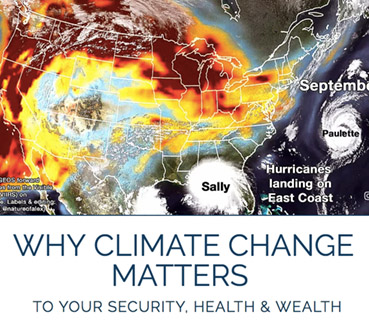 Why Climate Change Matters
Why Climate Change Matters  website
website
This website explains 10 key reasons why climate change matters (see list below). Each point is evidence-based and supported with maps, graphs, and photos.
- Climate change is the primary threat to global security
- We are experiencing a “new climate reality” and humans are the major cause
- Climate change and its consequences require local knowledge
- Climate can change suddenly
- Climate change causes severe health consequences
- Climate change adaptation & mitigation are creating enduring jobs, workforce development, and wealth
- Clean air laws improve human and ecosystem health, but require strict enforcement
- Water is the new oil – the most precious resource on the planet
- Renewable energy and lower demand are essential, but they require government support
- Geoengineering solutions will not replace mitigation, adaptation and conservation
Related NGSS
- DCI: Natural resources and hazards; human impacts; adaptation; biodiversity; ecosystem interactions.
- CCC: Stability and change; Cause and effect; mechanism and explanations.
- SEP: Analyze and interpret data.
Grades 9–12
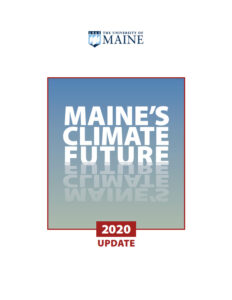 Maine’s Climate Future 2020 Update
Maine’s Climate Future 2020 Update  PDF
PDF
Maine’s Climate Future (MCF) 2020 Update is a report that presents the most recent information on Maine’s changing climate, impacts to our critical natural resources, adaptation measures, and what we are likely to see in the future. While great challenges lie ahead, significant action today can avoid the worst-case scenarios for our future and build a sustainable society that we owe to future generations.
Previous MCF reports released in 2009 and 2015 are also available.
Related NGSS
- DCI: Human impacts and actions; natural resources.
- SEP: Analyze and interpret data.
Grades 9–12
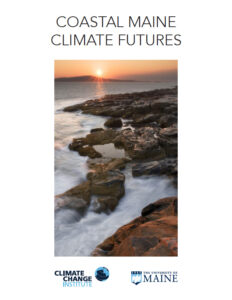 Coastal Maine Climate Futures
Coastal Maine Climate Futures  PDF
PDF
Climate and weather exert a critical influence on the health of Maine’s people, ecosystems and economy. Across coastal communities, where fishing, forestry, tourism, and agriculture serve as the economic backbone, the changing climate poses near and long-term challenges. This report provides a basis for future planning by developing plausible climate scenarios for the next 20 years – the period 2020–2040. The plausible scenarios follow an examination of historical climate trends, climate–commodity connections, and sources of climate variability that affect Maine. This report was produced with generous support from the Russell Grinnell Memorial Trust.
Related NGSS
- DCI: Human impacts and actions; natural resources.
- SEP: Analyze and interpret data.
Grades 9–12
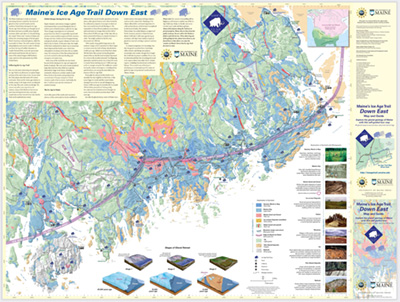 Ice Age Trail Map & Guide
Ice Age Trail Map & Guide  website
website  PDF
PDF
The Maine landscape is made up of many interesting features created by vast sheets of glacial ice that covered Canada and the northern United States during the Ice Age. The Maine Ice Age Trail Map & Guide will lead you through one of the finest and most accessible areas of glacial moraines, deltas and eskers. It is located along the coastal “Down East” section of Maine and follows the retreating margin of the last great North American continental glacier, called the Laurentide Ice Sheet. The trail consists of stops along highways and country roads. It will take you from the top of Cadillac Mountain in Acadia National Park, along coastal zones, across the spectacular and remote sand barrens that are home to some of the nation’s largest wild blueberry crops, and on to the easternmost point of the United States at Lubec.
Related NGSS
- DCI: Earth system interactions.
- CCC: Stability and change.
Grades 6–12
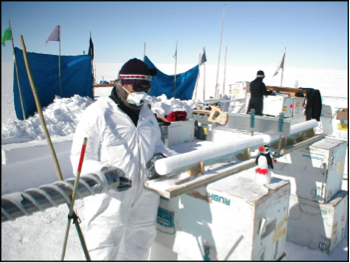 Ice Core Perspectives
Ice Core Perspectives  website
website
This website describes how ice cores are collected and how they can be used to understand past climate variability.
Related NGSS
- DCI: Earth system interactions.
- CCC: Stability and change.
- SEP: Plan and conduct investigations.
Grades 6–12
Climate Data Tools
Climate data offers a rich context for building skills in graphing, analyzing and interpreting data. The resources in this section are interactive platforms where students can create graphs and maps, or access data files, to look for patterns in climate and weather over long or short timeframes, and at local, regional, continental and global scales.
 Climate Reanalyzer
Climate Reanalyzer  website
website
Climate Reanalyzer is a website for graphing and mapping climate and weather data. Users can explore current conditions in any world region, show changes in climate through time, and explore differences across regions around the world. In particular, the site provides access to “reanalysis” models, which utilize historical surface, weather balloon, and satellite observations to estimate recent climate (past several decades). Reanalysis models produce outputs such as temperature, precipitation, wind, and other variables using mathematical and physical calculations also used in weather forecast models. Pages on Climate Reanalyzer include:
- Today’s Weather – global maps showing the current day’s weather, including the temperature departure from a long-term historical mean
- Tools for accessing monthly, seasonal, and annual weather outputs from climate reanalysis models (maps, time series [including spreadsheets], and variable correlation analysis)
- Daily maps of global temperature, sea surface temperature, and sea ice for any day from January 1, 1979 to present
- Monthly, seasonal, and annual U.S. temperature and precipitation (maps, time series, spreadsheets)
- Monthly, seasonal, and annual global sea surface temperature for the past several decades (maps, time series)
- Hourly weather forecast maps from several models for global, U.S., and regional domains
- NOAA Satellite Imagery
Student Investigations: A document with example Climate Reanalyzer learning activities can be downloaded here.
Related NGSS
- DCI: Global and local climate and weather; systems and models; scale, quantity, and proportion.
- SEP: Analyze and interpret data; use models.
Grades 8–12
 Maine Climate Office
Maine Climate Office  website
website
The Maine Climate Office website is a one-stop-shop for access to past, present, and forecast climate and weather data for Maine. The site is maintained by the Maine State Climatologist, Dr. Sean Birkel. Pages include:
- Monthly, seasonal, and annual temperature & precipitation, statewide and by climate division (maps, time series, spreadsheets)
- Daily temperature & precipitation, statewide station data (time series, spreadsheets)
- Gulf of Maine daily sea surface temperature (maps, time series)
- Hourly weather forecast maps from several models for global, U.S., and regional domains (content from Climate Reanalyzer)
- NOAA temperature, precipitation, and drought outlooks
- Links to Maine climate reports and research
Related NGSS
- DCI: Global and local climate and weather; systems and models; scale, quantity, and proportion.
- SEP: Analyze and interpret data; use models.
Grades 5–12
 10Green
10Green  website
website
10Green is an interactive tool that provides a comprehensive assessment of the health of your environment. 10Green uses publicly available data from U.S. environmental monitoring programs, and leverages decades of ice core research that has allowed us to understand how the chemistry of Earth’s atmosphere has changed as a consequence of human activities. The 10 air quality measures utilized here represent some of the most significant threats to human health.
Related NGSS
- SEP: Analyze and interpret data.
Grades 8–12
Climate Datasets on Tuva  website
website
Online library of many CCI and other climate datasets that students can explore using Tuva’s graphing
platform.
Related NGSS
- SEP: Analyze and interpret data; use models.
Grades 5–12
Simple Climate Models
This section includes models that students can use to explore what climate scenarios may unfold under different assumptions or conditions.
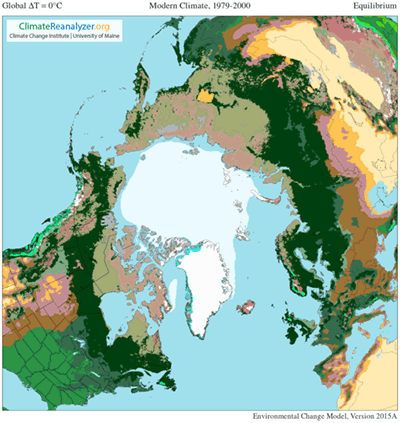 Environmental Change Model
Environmental Change Model  website
website
The Environmental Change Model (ECM) estimates snow/ice mass balance and potential biomes across the globe for climate boundary conditions ranging from Last Glacial Maximum (LGM; ~ 20,0000 years ago) to 2100 CE. Solutions are calculated from gridded inputs of monthly temperature and precipitation using a degree day solver and biome rubric. Boundary conditions for a given experiment are derived by blending reanalysis (modern climate) and general circulation model (past and future climate) climatologies. Solution output from the ECM is available through an interface on Climate Reanalyzer.
Related NGSS
- PE: HS-ESS3-5 — Analyze geosciences data and data from climate models.
Grades 9–12
Earth Energy Balance Model  spreadsheet
spreadsheet
Google spreadsheet made so that students can model changes to Earth’s temperature given selected parameters of albedo, CO2, and emissivity (Bradfield Lyon, 2017).
Related NGSS
- DCI: Heat transfer.
- CCC: Flow of matter and energy; model systems.
- PE: HS-ESS3-5 — Analyze geosciences data and data from climate models.
Grades 9–12
Video and Virtual Library
Earth’s climate system involves interactions among all five Earth systems — air, water, ice, earth, and life (including humans). To study climate, scientists at the Climate Change Institute travel to many corners of the Earth to observe and record past and present changes in specific parts of Earth’s systems. They analyze their observations and measurements to understand how the climate system works, and to predict how it is likely to change in the future. Videos in this section show what some CCI researchers do, and what kinds of questions they are investigating. Additional CCI video content is available elsewhere on the CCI website and also on our YouTube channel.
 National Geographic Mount Everest Expedition
National Geographic Mount Everest Expedition
In 2019, National Geographic funded a major research expedition to Mt. Everest with a multi-disciplinary team of scientists led by CCI Director, Paul Mayewski. These videos show stunning images of the Himalayas, as biologists, geologists, meteorologists, glaciologists, and mapmakers on the team describe their questions and gather evidence.
- Explorers in the Field
 video (7 min)
video (7 min)
Collecting data at the peak of the world, Paul Mayewski and his multidisciplinary team of scientists endeavor to understand the full impact of climate change on one of the most extreme places on earth: Mount Everest. - Expedition Everest: The Mission (360°)
 video (4 min)
video (4 min)
Describes the risks of working in such a challenging high-altitude environment. - Glaciology: Truth is in the Ice

 video (8 min)
video (8 min)
A team of scientists and Sherpa guides sets out to collect information about glacial change in the Himalayas. By extracting ice cores from the highest glacier in the world, the team has begun to uncover details about climate change that have – until now – been hidden in this hard-to-reach ice. - Geology: History is in the Mud

 webpage/video (8 min)
webpage/video (8 min)
Geologists describe what mud from glacial lakes tell about our history and future. - Biology: Life is on the Rise

 webpage/video (5 min)
webpage/video (5 min)
Biologists investigate how alpine species are adapting to climate change. - Mapping: Change is on the Map

 webpage/video (8 min)
webpage/video (8 min)
Mapmakers use technology to digitally reconstruct the topography of the Khumbu Glacier to study how it is changing and how changes will affect water resources in the region. - Meteorology: Data is in the Clouds

 webpage/video (8 min)
webpage/video (8 min)
Follow the team of scientists that climbed to “The Balcony”, near the top of Everest, to set up the world’s highest weather station. Weather data from five stations
associated with the Everest project can be downloaded here.
Related NGSS
- DCI: Earth system interactions.
- CCC: Stability and change.
- SEP: Ask questions and define problems; plan and conduct investigations; Obtain, evaluate, and communicate information.
Grades 7–12
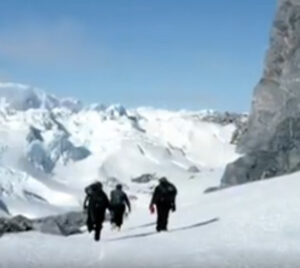 A Journey to Reedy Glacier, Antarctica
A Journey to Reedy Glacier, Antarctica
This is a series of twelve short videos about a CCI expedition to Reedy Glacier, Antarctica, led by Dr. Brenda Hall. The research team is investigating past changes to Reedy glacier in order to better understand the stability of the marine-based West Antarctic Ice Sheet. Stability of the ice sheet has implications for future sea-level rise in the warming climate. Click a video link below or view the YouTube index for this series here.
- Why is Everyone Talking About Climate Change?
 video (2 min) [YouTube]
video (2 min) [YouTube]
Introduces the problem of climate change and the consequence of sea-level rise as the context for the research team’s interest in studying glaciers in Antarctica. - Welcome to Reedy Glacier, Antarctica
 video (2 min) [YouTube]
video (2 min) [YouTube]
Describes the geography of Antarctica, the West Antarctic Ice Sheet, and Reedy Glacier. - Why do Scientists Go to Antarctica?
 video (2 min) [YouTube]
video (2 min) [YouTube]
Dr. Hall describes the big questions and reasons why the research is important and introduces the research team. - Daily Life at Reedy Glacier
 video (3 min) [YouTube]
video (3 min) [YouTube]
Researchers describe the logistics of getting to Reedy Glacier, what it’s like to live on the ice, and what a typical day studying Reedy Glacier involves. - What Questions are the Researchers Evaluating?
 video (2 min) [YouTube]
video (2 min) [YouTube]
Dr. Hall connects the big questions to smaller questions that can be answered with measurable observations. - What Might be the Answer?
 video (2 min) [YouTube]
video (2 min) [YouTube]
The researchers explain what they are specifically at Reedy Glacier to find out: their hypothesis that the West Antarctic Ice Sheet is still retreating. - What Evidence Helps Answer the Question?
 video (2 min) [YouTube]
video (2 min) [YouTube]
Dr. Hall describes what they measured in the field to find evidence of past fluctuations in the ice sheet, and how, when they returned home, they mapped and dated the glacial deposits they found. - What Can Rocks Tell Us About Glacier Age?
 video (2 min) [YouTube]
video (2 min) [YouTube]
Dr. Stone explains the process of cosmogenic dating and how cosmic rays are used to calculate the age of rocks exposed at Earth’s surface. - What Did the Researchers Find?
 video (2 min) [YouTube]
video (2 min) [YouTube]
Dr. Bromley describes their finding that Reedy Glacier has thickened and thinned many times in the past. - What Does the Evidence Mean to the Researchers?
 video (2 min) [YouTube]
video (2 min) [YouTube]
Dr. Hall explains what they learned about how the WAIS thickened then thinned since the last glacial maximum 18,000 years ago, and that its thinning appears to have slowed in the past few thousand years. - What Do We Know, and What Do We Still Need to Learn?
 video (2 min) [YouTube]
video (2 min) [YouTube]
Dr. Hall puts their findings in a broader context of what is known about ice sheets in other areas of Antarctica, and how it relates to wider concerns about the melting of ground-based ice sheets. - Acadia and Antarctica
 video (3 min) [YouTube]
video (3 min) [YouTube]
Mr. Bromley connects the observations their team made of glaciers in Antarctic to the same processes that occurred in Maine 14,000 years ago as the Laurentide ice sheet retreated and left its marks that are still evident on Maine’s landscape today.
Related NGSS
- DCI: Earth system interactions.
- CCC: Stability and change.
- SEP: Ask questions and define problems; plan and conduct investigations; Obtain, evaluate, and communicate information.
Grades 6–12
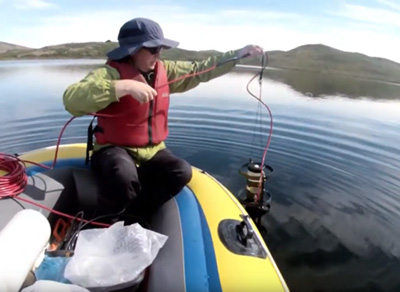 Virtual Fieldwork in Greenland
Virtual Fieldwork in Greenland  website
website  video (8 min) [YouTube]
video (8 min) [YouTube]
Have your students ever wondered what it would be like to do climate change research? How about to visit the Arctic? Now you can give them a taste with this inquiry-based Virtual Fieldwork Experience (VFE). Students and teachers gain exclusive access into cutting edge research from the University of Maine Climate Change Institute. With documentary footage, real data from the Arctic, and a GIS layer for Google Earth visualization, this VFE introduces students to concepts from biology, lake ecology, earth science, and climate studies. The tool was designed using current best practices for engaging diverse learners (including English Language Learners) in science classrooms and provides a video introduction allowing students to see and hear key terms prior to engaging with data.
NGSS Middle School
- MS-LS2 Ecosystems: Interactions, Energy, and Dynamics
- MS-ESS2 Earth’s Systems
NGSS High School
- HS-LS2 Ecosystems: Interactions, Energy, and Dynamics
- HS-LS4 Biological Evolution: Unity and Diversity
- HS-ESS2 Earth’s Systems
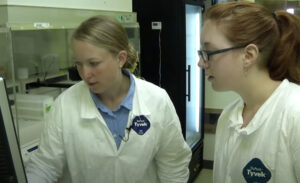 How Do Ice Cores Allow Researchers to Look at Global Climate Change?
How Do Ice Cores Allow Researchers to Look at Global Climate Change?  video (5 min) [YouTube]
video (5 min) [YouTube]
CCI PhD. candidate Bess Kaufman and Earth Sciences undergraduate student Eliza Kane provide an overview of how ice cores are processed, and how they can be utilized by researchers to understand many different aspects of climate.
Related NGSS
- DCI: Climate history.
- CCC: Stability and change.
- SEP: Plan and conduct investigations.
Grades 9–12
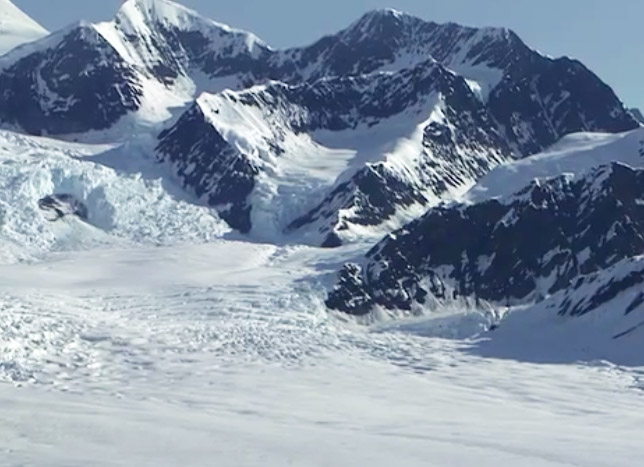 Alaska Mountain Glaciers Retreating Due to Climate Change
Alaska Mountain Glaciers Retreating Due to Climate Change  video (4 min) [YouTube]
video (4 min) [YouTube]
Tighten your seat belt! This runway is made of ice. Welcome to the Ruth Glacier, deep inside Alaska’s Denali National Park. Many of the visitors are here for back country skiing, but this is no vacation for University of Maine paleoclimatologist Karl Kreutz and his team. For them, time on the ice is all part of the job. With support from the National Science Foundation, the scientists are working to reconstruct the climate history of this area over the last thousand years. They’re researching the relationship between the temperatures and precipitation rates, and the response of glaciers in this area to climate changes.
Related NGSS
- DCI: Climate history.
- CCC: Stability and change.
Grades 9–12
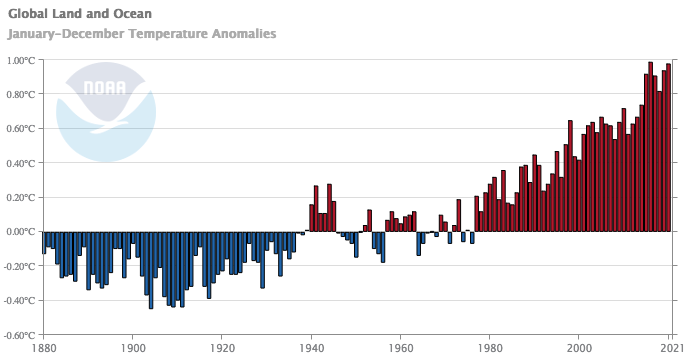 Climate Change: Scientific Evidence or Alternative Facts
Climate Change: Scientific Evidence or Alternative Facts  video (1h 3 min) [YouTube]
video (1h 3 min) [YouTube]
CCI Director Dr. Paul Mayewski discusses the differences between the approaches of the Intergovernmental Panel on Climate Change (IPCC) and the Heartland Institute’s Nongovernmental International Panel on Climate Change (NIPCC).
Discussion Prompts: A document with charts from the video to use in discussion can be downloaded here.
Related NGSS
- DCI: Earth system interactions.
- CCC: Stability and change.
- SEP: Ask questions and define problems; plan and conduct investigations; Obtain, evaluate, and communicate information.
Grades 9–12
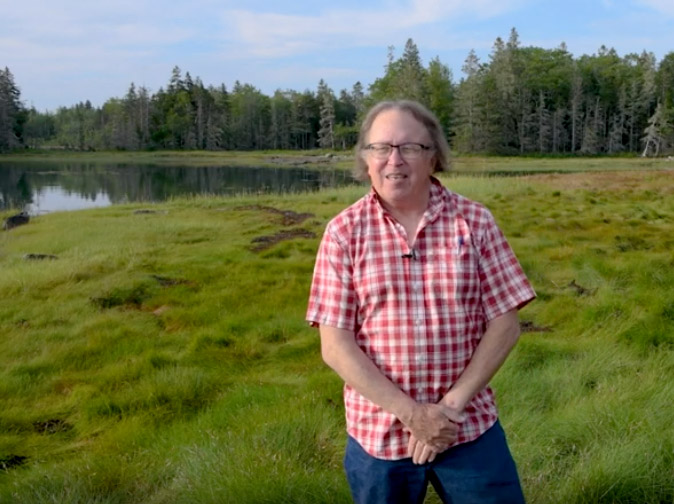 Rising Tides: Changes in Sea Level along the Maine Coast
Rising Tides: Changes in Sea Level along the Maine Coast  video (13 min) [YouTube]
video (13 min) [YouTube]
Dr. Joseph Kelley is a marine geologist who studies the sea floor, coastlines, and sea level. In this video, Dr. Kelley explains how we know that ocean levels are rising, and explores evidence for past and present changes in sea level at Acadia National Park in Maine.
Related NGSS
- DCI: Earth system interactions, climate history.
- CCC: Stability and change.
Grades 6–12
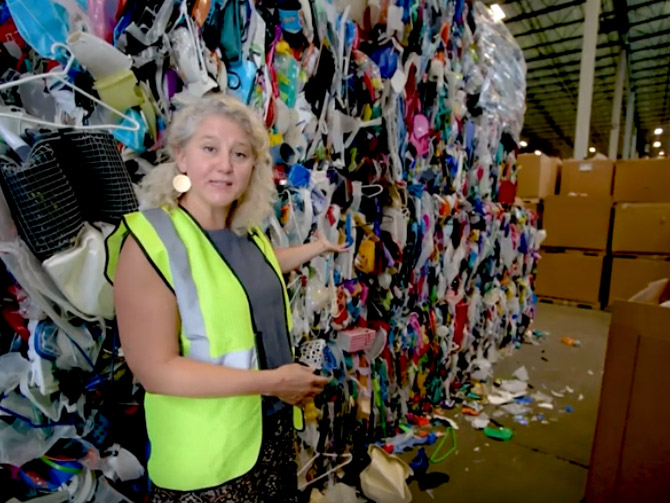 Relationship Between Climate Change and Consumption
Relationship Between Climate Change and Consumption  video (3 min) [YouTube]
video (3 min) [YouTube]
Dr. Cindy Isenhour discusses the climate impacts of resource consumption, and describes how greenhouse-gas emissions are embedded within the life cycle of manufactured products. Dr. Isenhour shows how adopting a circular economy of reusing, repairing, and making more durable goods can be a crucial part of climate change mitigation efforts.
Related NGSS
- DCI: Earth system interactions.
- CCC: Stability and change.
Grades 6–12
Flying Squirrel Research  video (3 min) [YouTube]
video (3 min) [YouTube]
An overview of research on flying squirrels being undertaken by Dr. Danielle Levesque and her students.
Grades 6–12
What’s Happening in Maine?
Climate Change and its consequences require local knowledge. Recent warming is not evenly distributed over the planet, and will affect different regions and communities in different ways. Local knowledge means understanding what changes are likely to have strong impacts on humans, economies, and health in your community – and supporting ways to mitigate those impacts.
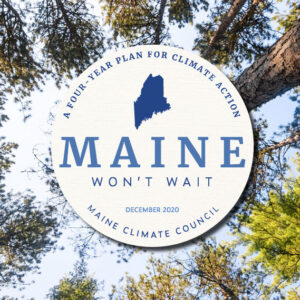 Maine Climate Council
Maine Climate Council  website
website
The Maine Climate Council is an assembly of scientists, industry leaders, bipartisan local and state officials, and engaged citizens working to address the effects of climate change on our state.
- Maine Won’t Wait: A Four-Year Plan for Climate Action
 PDF
PDF
Outlines four goals and eight strategies for addressing those goals over the next four years in response to climate change. - Scientific Assessment of Climate Change and its Effects in Maine
 PDF
PDF
The Maine Climate Council’s Scientific and Technical Subcommittee was responsible for delivering a report that summarizes the impacts of climate change in Maine and how it might impact our state in the future.
Their final report is part of the State Climate Action Plan. The findings from this report inform the ongoing deliberations of the Maine Climate Council and have aided the Maine Climate Council’s six working groups in the development of their draft recommended strategies. In addition, the Scientific and Technical Subcommittee identified critical scientific information gaps and needs to better understand and forecast potential future climate change impacts in the State.
Related NGSS
- DCI: Human impacts and actions.
Grades 9–12
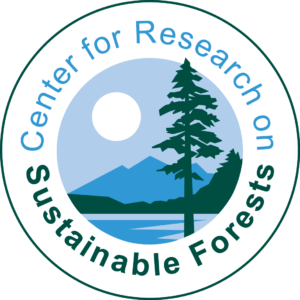 Center for Research of Sustainable Forests
Center for Research of Sustainable Forests  website
website
The mission of the Center for Research on Sustainable Forests (CRSF) is to conduct and promote leading interdisciplinary research on issues affecting the management and sustainability of northern forest ecosystems and Maine’s forest-based economy.
Related NGSS
- DCI: Natural Resources.
Grades 9–12
 Maine Climate and Agriculture Network
Maine Climate and Agriculture Network  website
website
The Maine Climate and Agriculture Network (MECAN) is a group of individuals organized through the University of Maine who recognize the importance of climate and weather impacts on agriculture. Participation is open to all who wish to contribute to the shared mission. The website provides information and resource links relevant to Maine farms such as projected changes in growing seasons, frost dates, plant hardiness zones, storm intensity, water availability, and crop, pest and disease forecasts.
Featured Resource: Farm Response to Changing Weather
Related NGSS
- DCI: Natural Resources.
- SEP: Analyze and interpret data.
Grades 9–12

